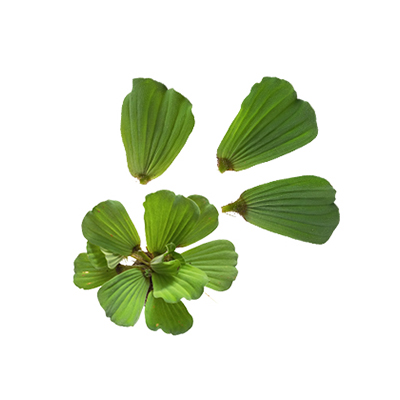Kariba Weed
Salvinia molesta D. Mitch
Salviniaceae
Location in our garden
Aquatic



Synonym
Salvinia adnata Desv.
Habitus
Aquatic. A perennial, heterosporous herbs, free floating, up to 30 cm long, 5 cm wide.
Part Used
Leaves
Growing Requirements
Full Sunshine
Habitat
Aquatic
Overview
Salvinia molesta is native to south and south-east Brazil to Argentina. It is distributed and naturalised in Africa, the Indian Sub-continent, south-eastern Asia, warmer parts of Australia and New Zealand, southern USA and several Pacific islands. Thick mats of Salvinia molesta cut off light to submerged plants, often outcompeting rooted and submerged native plants and reducing vascular plant diversity. It is an important plant host of Mansonia spp. mosquitoes, which have been identified as vectors of West Nile Virus, Venezuelan Equine Encephalitis and rural elephantiasis. It also shelters mosquito species that are responsible for the transmission of encephalitis, malaria and dengue fever in other areas. It provides food for some fish and, if sparsely distributed, also provides shade and shelter. Potential uses of the plant include as a compost and mulch, and as a supplement to livestock feed. S. molesta is not only efficient at removing nutrients from water but also in removing heavy metals, making it potentially useful in a variety of wastewater applications. A few studies have also investigated using S. molesta for biogas production.
Vernacular Names
Fougère d’eau (French), Lästiger büschelfarn (German), Drijfplantje (Dutch), Rikkakellussaniainen (Finland), Chawk hunu (Thai).
Agroecology
Salvinia molesta occurs in rivers, streams, lakes, dams, swamps, irrigation channels, drainage lines and other bodies of water and is also a pest of paddy rice crops around the world. Mainly a weed of tropical, subtropical and warmer temperate regions. Grows rapidly and can quickly cover the entire surface of (small and medium-sized) waterbodies with a thick mat of vegetation, shading out any submerged plant life. It prefers stagnant or slow moving water, often in small bays and inlets of dissected shorelines and tributaries of small streams, where it is protected from wave action. It will also grow around emergent brush and trees on flooded shorelines where it is also sheltered from wave action. It can also survive on mudbanks, and will tolerate some drying. It is quickly killed by sea water but can tolerate lower concentrations of salt. S. molesta has a low tolerance of salinity. Optimum growth occurs in nutrient-rich situations, pH 6-7.5, with water temperatures between 20 and 30 °C.
Morphology
- Root - absent.
- Stem - has slender, branching runners and form mats of vegetation very quickly.slender stems (1-2 mm thick) are much-branched and grow up to 30 cm long (usually only 6-25 cm long) before separating to form new plants. The length of stem between the joints (nodes), that is the internode length, varies depending on the density of the weed. When plant density is low the 'internode' length is relatively long, but as plant density increases, the 'internode' length may become very short.
- Leaves - short petiolate, in whorls of three, two upper and one lower; upper leaves floating, photosynthetic, entire, elliptic-ovate to rounded, with a distinct midvein, aerolate, 0.7-3 cm long, to 1.8 cm wide, apices rounded to emarginate, the aerolae either fairly uniform in size throughout, or inner longer than outer; papillae apex split into several hairs that form a birdcage-like structure which traps an air bubble when submerged, creating a non-wettable upper surface; leaves often folded in half under crowded growth conditions; lower leaves subsessile or petiolate, with or without sporocarps attached, 1.5-2.0 cm long, to 0.5 cm wide, the petiole to 3 cm long, submersed, non-photosynthetic, finely divided into linear segments (feathery), segments appearing as and functioning as roots.
Cultivation
S. molesta is a sterile pentaploid hybrid fern that forms spore sacs containing abortive spores due to anomalies during meiosis. Since the spores and megagametophytes that are produced are fairly short-lived, reproduction is exclusively vegetative: vegetative reproduction by growth and fragmentation.
Chemical Constituents
Tannins, lignin, glycosides (6'-O-(3,4-dihydroxy benzoyl)-beta-D-glucopyranosyl ester, and 4-O-beta-d-glucopyranoside-3-hydroxy methyl benzoate), methyl benzoate, hypogallic acid, caffeic acid, paeoniflorin, and pikuroside, quinone, terpenoid, flavonoid, phenolic compounds.
Traditional Medicinal Uses
It is used in the treatment of flu, fever, cough, rheumatism, dysentery, ulcer, edema, dysuria, gonorrhoea, urticaria, pruritus.
Part Used
Reference Sources
- BioNET-EAFRINET. (2011). Salvinia molesta (Kariba Weed). https://keys.lucidcentral.org/keys/v3/eafrinet/weeds/key/weeds/Media/Html/Salvinia_molesta_(Kariba_Weed).htm. 06-03-2022.
- CABI. (2022). Invasive Species Compendium: Salvinia molesta (kariba weed). https://www.cabi.org/isc/datasheet/48447. 06-03-2022.
- Choudhary, M.I., et al. (2008). Phenolic and other constituents of fresh water fern Salvinia molesta. Phytochemistry, 69(4):1018-23. DOI:10.1016/j.phytochem.2007.10.028.
- Kew Royal Botanic Gardens. (No date). Plants of The World Online: Salvinia molesta D.Mitch. https://powo.science.kew.org/taxon/urn:lsid:ipni.org:names:17453700-1. 06-03-2022.
- Moozhiyil, M., and Pallauf, J. (1986). Chemical Composition of the Water Fern, Salvinia molesta, and Its Potential as Feed Source for Ruminants. https://www.jstor.org/stable/4254879.06-03-2022.

